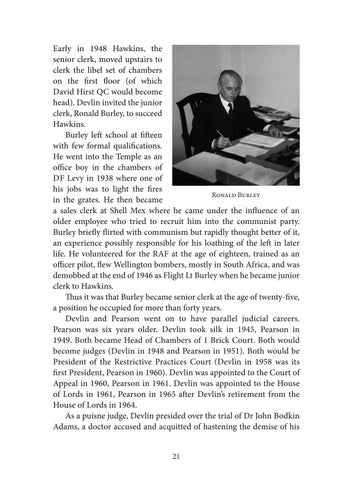Early in 1948 Hawkins, the senior clerk, moved upstairs to clerk the libel set of chambers on the first floor (of which David Hirst QC would become head). Devlin invited the junior clerk, Ronald Burley, to succeed Hawkins. Burley left school at fifteen with few formal qualifications. He went into the Temple as an office boy in the chambers of D F Levy in 1938 where one of his jobs was to light the fires Ronald Burley in the grates. He then became a sales clerk at Shell Mex where he came under the influence of an older employee who tried to recruit him into the communist party. Burley briefly flirted with communism but rapidly thought better of it, an experience possibly responsible for his loathing of the left in later life. He volunteered for the RAF at the age of eighteen, trained as an officer pilot, flew Wellington bombers, mostly in South Africa, and was demobbed at the end of 1946 as Flight Lt Burley when he became junior clerk to Hawkins. Thus it was that Burley became senior clerk at the age of twenty-five, a position he occupied for more than forty years. Devlin and Pearson went on to have parallel judicial careers. Pearson was six years older. Devlin took silk in 1945, Pearson in 1949. Both became Head of Chambers of 1 Brick Court. Both would become judges (Devlin in 1948 and Pearson in 1951). Both would be President of the Restrictive Practices Court (Devlin in 1958 was its first President, Pearson in 1960). Devlin was appointed to the Court of Appeal in 1960, Pearson in 1961. Devlin was appointed to the House of Lords in 1961, Pearson in 1965 after Devlin’s retirement from the House of Lords in 1964. As a puisne judge, Devlin presided over the trial of Dr John Bodkin Adams, a doctor accused and acquitted of hastening the demise of his 21
Issuu converts static files into: digital portfolios, online yearbooks, online catalogs, digital photo albums and more. Sign up and create your flipbook.














